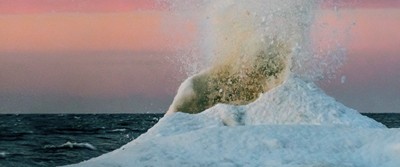Picture This: Ice Volcanoes on the Shores of Lake Michigan

By Gina Wynn
People who live near the Great Lakes know about the unusual weather effects they are capable of producing like lake-effect snow, cooler springs, and warmer falls. But few were aware of the Great Lakes’ power to produce mini ice volcanoes along their shorelines, until the snowy structures made their debut on social media.
Ever since an employee of the National Weather Service, Grand Rapids, Michigan, was able to snap a photo of one of the frosty beach anomalies during a frigid February walk and tweet about it, nature and weather enthusiasts have been captivated by the phenomenon.
What Are Ice Volcanoes?
According to the Live Science online article “Bizarre 'ice volcanoes' erupt on Lake Michigan beach,” by Nicoletta Lanese, the cone-shaped formations like the one photographed at Oval Beach on the eastern shore of Lake Michigan are not technically volcanoes.
In a Facebook post, Tom Niziol, winter weather expert for The Weather Channel, explained what the objects actually are and how the elements combine to make it look like a volcanic eruption has occurred.
When thin sheets of ice form at the edges of lakes, the water underneath pushes up into a mound. As the pressure under the ice increases, the water shoots out through holes that form in the ice. If it’s very cold, then that spray freezes, settles, and piles up until it eventually builds a cone-shaped structure.
A Novelty on the Great Lakes
Even though these ice cones are relatively rare, Niziol has also seen them along the eastern shores of Lake Erie. Others have observed them on the shores of Lake Ontario in New York and on Lake Michigan near Gary, Indiana.
The beaches of the Great Lakes are popular for such sightings because of the enormous sizes of the bodies of water, according to a news report by Matt Benz, AccuWeather meteorologist. Even though the temperature of the winter air is below freezing for long periods of time, the lakes don’t completely freeze.
"While this type of ice could develop on large lakes, most lakes outside of the Great Lakes in the U.S. tend to freeze up before you can accrete enough ice along the beaches," said Benz.
And oceans don’t present ideal conditions for ice volcanoes either. The saltwater needs much colder conditions in order to freeze and the harsher wave action prevents ices shelves from forming.
The Perfect Storm
When the photo of the ice volcano at Oval Beach was taken, Benz explained that the conditions were “just right” for the volcanic waterspout.
You need moderate wind and wave action and below-freezing temperatures for the occurrence, said Benz. The wind must be blowing in the right direction so the waves will form at the right angles. Freezing temperatures are necessary so the ice shelves will form. Then when large waves crash against them, the freezing water will build layers onto the structure.
If you plan to venture shoreside to get your own shot of a Great Lakes geyser, watch the weather forecast, bundle up, and hope the wind blows your way.
Discussion Questions
- Compare how real volcanos and ice volcanoes are similar. How are they different?
- Why are the Great Lakes unique? How were they formed?
Vocabulary
- Volcano
- Geyser
- Accrete